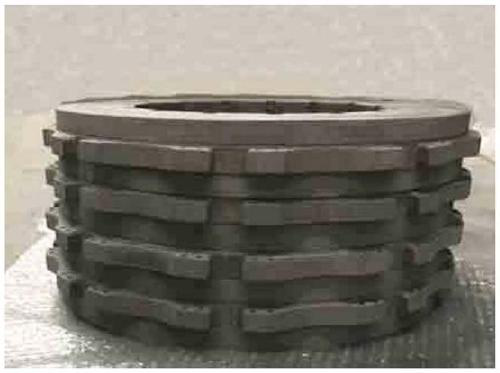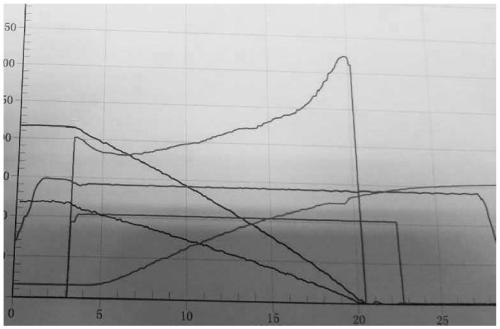Method for preparing carbon pottery aircraft brake disc
A brake disc and aircraft technology, applied in the direction of mechanical equipment, brake discs, brake types, etc., can solve the problems of material strength damage, brake system damage, high price, etc., and achieve the effect of solving residual silicon and improving friction performance
- Summary
- Abstract
- Description
- Claims
- Application Information
AI Technical Summary
Problems solved by technology
Method used
Image
Examples
Embodiment 1
[0053] The carbon pottery aircraft brake disc that will be prepared in the embodiment of the present invention 1, its green body used is that density is 1.32-1.44g / cm 3 The C / C Composite comes in a set of 9 pieces.
[0054] step one:
[0055] Prepare the impregnating solution I according to the mass ratio of polymethylsilane: styrene = 100:25, put the C / C body into a metal impregnation tank, vacuum impregnate for 2 hours, and pressurize for 8 hours. After the impregnation is completed, the impregnating solution I is released, and the impregnated green body is put into a graphite tooling and put into a cracking furnace at 900°C for cracking. The whole process is protected by an inert atmosphere, and the above impregnation-cracking process is repeated 3 times.
[0056] During vacuum impregnation, the vacuum degree is controlled to be ≤10Pa, and the pressurized impregnation pressure is 5.5MPa.
[0057] Step two:
[0058] The pre-finished product prepared in step 1 is subjecte...
Embodiment 2
[0073] The carbon pottery aircraft brake disk that will be prepared in the embodiment of the present invention 1, its green body used is that density is 1.05-1.28g / cm 3 The C / C Composite comes in a set of 9 pieces.
[0074] step one:
[0075] The impregnating solution was prepared according to the mass ratio of polymethylsilane: styrene = 100:30, and the C / C green body was placed in a metal impregnating tank, vacuum impregnated for 3 hours, and pressure impregnated for 7.5 hours. After the impregnation is completed, the impregnation liquid is released, and the impregnated green body is put into a graphite tooling and put into a cracking furnace for cracking at 1000°C. The whole process is protected by an inert atmosphere, and the above impregnation-cracking process is repeated 3 times.
[0076] During vacuum impregnation, the vacuum degree is controlled to be ≤10Pa, and the pressurized impregnation pressure is 6MPa.
[0077] Step two:
[0078] The pre-finished product prep...
Embodiment 3
[0094] The carbon pottery aircraft brake disc that will be prepared in the embodiment of the present invention 3, its green body used is that density is 1.35-1.49g / cm 3 The C / C Composite comes in a set of 9 pieces.
[0095] step one:
[0096] The impregnating solution is prepared according to the mass ratio of polymethylsilane: styrene = 100:20, and the C / C green body is placed in a metal impregnating tank, vacuum impregnated for 3 hours, and pressure impregnated for 6 hours. After the impregnation is completed, the impregnation liquid is released, and the impregnated green body is put into a graphite tooling and put into a cracking furnace at 900°C for cracking. The whole process is protected by an inert atmosphere, and the above impregnation-cracking process is repeated 3 times.
[0097] During vacuum impregnation, the vacuum degree is controlled to be ≤10Pa, and the pressurized impregnation pressure is 4MPa.
[0098] Step two:
[0099] The pre-finished product prepared ...
PUM
| Property | Measurement | Unit |
|---|---|---|
| density | aaaaa | aaaaa |
| particle diameter | aaaaa | aaaaa |
| softening point | aaaaa | aaaaa |
Abstract
Description
Claims
Application Information
 Login to View More
Login to View More - R&D
- Intellectual Property
- Life Sciences
- Materials
- Tech Scout
- Unparalleled Data Quality
- Higher Quality Content
- 60% Fewer Hallucinations
Browse by: Latest US Patents, China's latest patents, Technical Efficacy Thesaurus, Application Domain, Technology Topic, Popular Technical Reports.
© 2025 PatSnap. All rights reserved.Legal|Privacy policy|Modern Slavery Act Transparency Statement|Sitemap|About US| Contact US: help@patsnap.com


